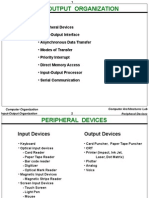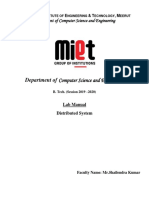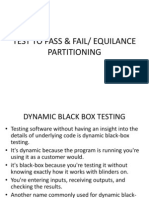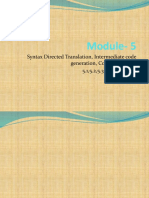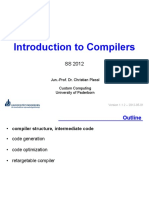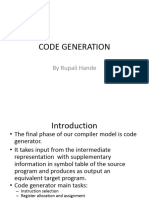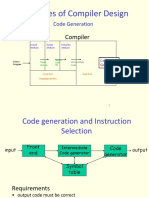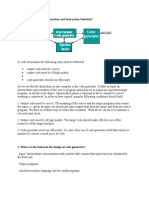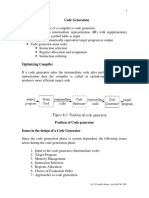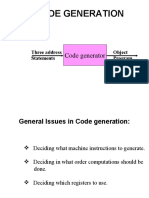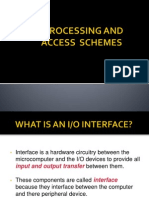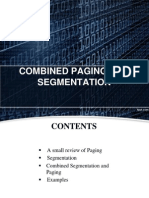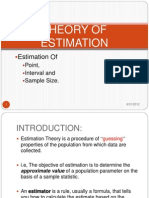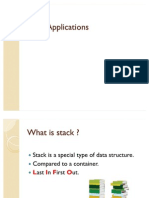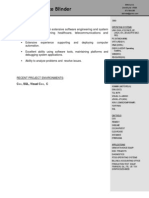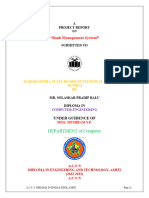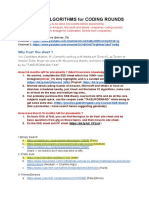CODE GENERATION
(Part I)
�Agenda
Introduction Code Generation Issues in the Design of a Code Generator The Target Language Addresses in the Target Code Basic Blocks and Flow Graphs Optimization of Basic Blocks Next
2
8/31/2012
�Introduction
The final phase in our compiler model
Intermediate Code Code Target Source Front End Intermediate Optimizer Generator program program code code
Position Of a Code Generator
8/31/2012
�Code Generation
This phase generates the target code consisting of assembly code.
1. Memory locations are selected for each variable;
2. Instructions are translated into a sequence of assembly instructions; 3. Variables and intermediate results are assigned to memory registers.
8/31/2012
�Issue in the Design of a Code Generator
Input to the Code Generator The Target Program Instruction Selection Register Allocation Evaluation Order
8/31/2012
�Input to the Code Generator
The input to the code generator is
The intermediate representation of the source program produced by the frontend along with the symbol table.
Choices for the IR
Three-address representations Virtual machine representations Linear representations Graphical representation
8/31/2012
�The Target Program
The instruction-set architecture of the target machine has a significant impact on the difficulty of constructing a good code generator that produces high-quality machine code. The most common target-machine architecture are RISC, CISC, and stack based.
A RISC machine typically has many registers, three-address instructions, simple addressing modes, and a relatively simple instruction-set architecture.
8/31/2012
�Contd
A CISC machine typically has few registers, two-address instructions, and variety of addressing modes, several register classes, variable-length instructions, and instruction with side effects. In a stack-based machine, operations are done by pushing operands onto a stack and then performing the operations on the operands at the top of the stack.
8/31/2012
�Instruction Selection
Instruction selection is important to obtain efficient code Suppose we translate three-address code
x:=y+z
to:
MOV y,R0 ADD z,R0 MOV R0,x
a:=a+1
MOV a,R0 ADD #1,R0 MOV R0,a Cost = 6
Better ADD #1,a Cost = 3
Better INC a Cost = 2
8/31/2012
�Register Allocation
A key problem in code generation is deciding what values to hold in what registers. Efficient utilization is particularly important. The use of registers is often subdivided into two sub problems:
1. Register Allocation, during which we select the set of variables that will reside in registers at each point in the program. 2. Register assignment, during which we pick the specific register that a variable will reside in.
8/31/2012
10
�Contd
Finding an optimal assignment of registers to variables is difficult, even with single-register machine. Mathematically, the problem is NP-complete.
8/31/2012
11
�Evaluation Order
The order in which computations are performed can affect the efficiency of the target code. Some computation orders require fewer registers to hold intermediate results than others. However, picking a best order in the general case is a difficult NP-complete problem.
8/31/2012
12
�The Target Language
A Simple Target Machine Model Program and Instruction Costs
8/31/2012
13
�A Simple Target Machine Model
Our target computer models a three-address machine with load and store operations, computation operations, jump operations, and conditional jumps. The underlying computer is a byte-addressable machine with n general-purpose registers.
8/31/2012
14
�Contd
Assume the following kinds of instructions are available:
Load operations Store operations Computation operations Unconditional jumps Conditional jumps
8/31/2012
15
�Contd
Assume a variety of addressing models:
A variable name x referring o the memory location that is reserved for x. Indexed address, a(r), where a is a variable and r is a register. A memory can be an integer indexed by a register, for example, LD R1, 100(R2). Two indirect addressing modes: *r and *100(r) Immediate constant addressing mode
8/31/2012
16
�A Simple Target Machine Model
Example :
x = y z
LD R1, y LD R2, z SUB R1, R1, R2 ST x, R1
x = *p
LD R1, p LD R2, 0(R1) ST x, R2
b = a[i]
LD R1, i MUL R1, R1, 8 LD R2, a(R1) ST b, R2
*p = y
LD R1, p LD R2, y ST 0(R1), R2
8/31/2012
17
�a[j] = c
LD R1, c LD R2, j MUL R2, R2, 8 ST a(R2), R1
if x < y goto L
LD R1, x LD R2, y SUB R1, R1, R2 BLTZ R1, L
8/31/2012
18
�Program and Instruction Costs
For simplicity, we take the cost of an instruction to be one plus the costs associated with the addressing modes of the operands.
Addressing modes involving registers have zero additional cost, while those involving a memory location or constant in them have an additional cost f one.
8/31/2012
19
�Contd
For example,
LD R0, R1 cost = 1
LD R0, M cost = 2 LD R1, *100(R2) cost = 3
8/31/2012
20
�Addresses in the Target Code
Static Allocation Stack Allocation Run-Time Allocation
8/31/2012
21
�Static Allocation
Focus on the following three-address statements:
Call callee Return Halt Action
8/31/2012
22
�Static Allocation
Store return address and return control to caller Store ST callee.staticArea , #here + 20 BR callee.codeArea Return BR *callee.staticArea
8/31/2012 23
�Runtime Addresses for Names
Assumption: a name in a three-address statement is really a pointer to a symboltable entry for that name. Note that names must eventually be replaced by code to access storage locations
8/31/2012
24
�Contd
Example:
x=0
Suppose the symbol-table entry for x contains a relative address 12 x is in a statically allocated area beginning at address static the actual run-time address of x is static + 12 The actual assignment: static [ 12] = 0 For a static area starting at address 100: LD 112, #0
8/31/2012
25
�Basic Blocks and Flow Graphs
Basic Blocks Next-Use Information Flow Graphs Representation of Flow Graphs Loops
8/31/2012
26
�Basic Blocks
Algorithm: Partitioning three-address instructions into basic blocks.
INPUT: A sequence of three-address instructions. OUTPUT: A list of the basic blocks for that sequence in which each instruction is assigned to exactly one basic block.
8/31/2012
27
�Contd
METHOD: First, we determine those instructions in the intermediate code that are leaders. rules for finding leaders are: 1. The first three-address instruction in the intermediate code is a leader. 2. Any instruction that is the target of a conditional or unconditional jump is a leader. 3. Any instruction that immediately follows a conditional or unconditional jump is a leader.
8/31/2012
28
�Contd
Find the leaders
8/31/2012
29
�Next-Use Information
The use of a name in a three-address statement:
Three-address statement i assigns a value to x Statement j has x as an operand Control can flow from statement i to j along a path that has no intervening assignments to x Then statement j uses the value of x computed at i .
Say that x is live at statement i .
8/31/2012
30
�Next-Use Information
Algorithm (for x=y+z) : Determining the liveness and next-use information for each statement in a basic block.
INPUT: A basic block B of three-address statements. Assume the symbol table initially shows all nontemporary variables in B as being live on exit.
OUTPUT: At each statement i : x = y + z in B, attach to i the liveness and next-use information of x, y, and z .
8/31/2012
31
�Contd
METHOD: Start at the last statement in B and scan backwards to the beginning of B. At each statement i: x = y + z in B, do the following: 1. Attach to i the information currently found in the symbol table regarding the next use and liveness of x , y, and z. 2. In the symbol table, set x to "not live" and "no next use." 3. In the symbol table, set y and z to "live" and the next uses of y and z to i.
8/31/2012
32
�Flow Graphs
A flow graph is a graphical depiction of a sequence of instructions with control flow edges A flow graph can be defined at the intermediate code level or target code level
MOV 1,R0 MOV n,R1 JMP L2 L1: MUL 2,R0 SUB 1,R1 L2: JMPNZ R1,L1 MOV 0,R0 MOV n,R1 JMP L2 L1: MUL 2,R0 SUB 1,R1 L2: JMPNZ R1,L1
8/31/2012
33
�Loops
A loop is a collection of basic blocks, such that
All blocks in the collection are strongly connected The collection has a unique entry, and the only way to reach a block in the loop is through the entry
8/31/2012
34
�Optimizing of Basic Block
Compile time evaluation Common sub-expression elimination Code motion Strength Reduction Dead code elimination Algebraic Transformations
�Compile-Time Evaluation
Expressions whose values can be pre-computed at the compilation time Two ways: Constant folding Constant propagation
36
�Compile-Time Evaluation
Constant folding: Evaluation of an expression with constant operands to replace the expression with single value Example:
area := (22.0/7.0) * r ^ 2
area := 3.14286 * r ^ 2
37
�Compile-Time Evaluation
Constant Propagation: Replace a variable with constant which has been assigned to it earlier.
Example:
pi := 3.14286
area = pi * r ^ 2
area = 3.14286 * r ^ 2
�Common Sub-expression Elimination
Local common sub-expression elimination Performed within basic blocks.
a := b * c
x := b * c + 5
temp := b * c a := temp x := temp + 5
�Code Motion
Moving code from one part of the program to other without modifying the algorithm
Reduce size of the program Reduce execution frequency of the code subjected to movement
40
�Code Motion
Similar to common sub-expression elimination but with the objective to reduce code size.
If(a<b) then z:= x * 5 else y := x * 5 + 2
temp := x * 2 If(a<b) then z:= temp else y := temp + 2
�Strength Reduction
Replacement of an operator with a less costly one.
X=x^2
X=x*x
Y=y*2
Y=y+y
�Dead Code Elimination
Dead Code are portion of the program which will not be executed in Basic block.
If(a==b) { b=c ; .. return b ; c=0; }
If(a==b) { b=c ; .. return b ; }
�References
Alfred V. Aho, Ravi Sethi, and Jeffrey D. Ullman, Compilers: Principles, Techniques, and Tools Addison-Wesley, 1986.
http://en.wikipedia.org/wiki/Code_generation_(compiler) http://www.mec.ac.in/resources/notes/notes/compiler/mo dule5/codegenissues.htm
8/31/2012
44


